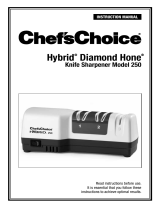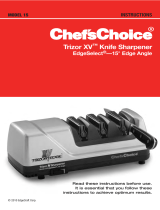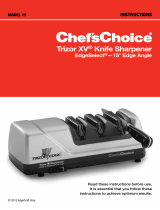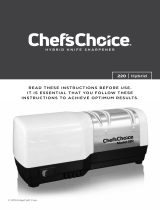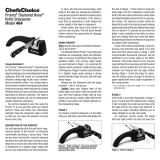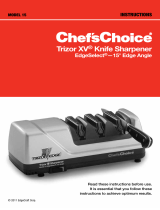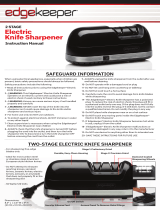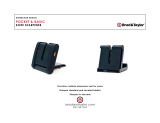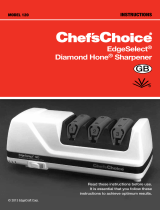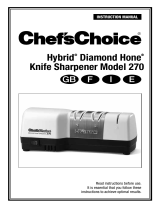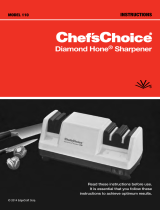
INSTRUCTION MANUAL
Hybrid
®
AngleSelect
®
Diamond Hone
®
Knife Sharpener
Model 290
Read instructions before use.
It is essential that you follow these
instructions to achieve optimal results.

2
IMPORTANT SAFEGUARDS
When using electrical appliances, basic safety precautions should always
be followed including the following:
1. Read all instructions. For your safety, every user should read this manual.
2. To protect against electrical hazards, do not immerse the Chef’sChoice
®
Hybrid
®
sharpener in water or other liquid.
3. Make sure that only clean knife blades are inserted in Model 290.
4. Unplug from outlet when not in use and before cleaning.
5. Avoid contacting moving parts.
6. Do not operate any appliance with a damaged cord or plug or after the appliance
malfunctions, or is dropped or damaged in any manner.
U.S. customers: You can return your sharpener to EdgeCraft’s factory for service where
the cost of repair or electrical or mechanical adjustment can be estimated. When the
electrical cord on this appliance is damaged, it must be replaced by the Chef’sChoice
®
factory or other qualified service to avoid the danger of electrical shock.
Outside U.S.: Please return your sharpener to your local distributor where the cost of
repair or electrical or mechanical adjustment can be estimated. If the supply cord of
this appliance is damaged, it must be replaced by a repair facility appointed by the
manufacturer because special tools are required. Please consult your Chef’sChoice
®
distributor.
7. CAUTION! This appliance may be fitted with a polarized power plug (one blade is wider
than the other). To reduce the risk of electric shock, this plug will fit in a polarized outlet
only one way. If the plug does not fit fully in the outlet, reverse the plug. If it still does not
fit, contact a qualified electrician. Do not modify the plug in anyway.
8. The use of attachments not recommended or sold by EdgeCraft Corporation may cause
fire, electric shock or injury.
9. The Chef’sChoice
®
Model 290 sharpener is designed to sharpen American, European,
and Asian style knives as described in following sections. Do not attempt to sharpen
scissors, ax blades or any blade that does not fit freely in the slots.
10. Do not let the cord hang over edge of table or counter or touch hot surfaces.
11. When in the “ON” position (Red flash on switch is exposed when “ON”), the
Chef’sChoice
®
sharpener should always be on a stable countertop or table.
12. WARNING: KNIVES PROPERLY SHARPENED ON YOUR Chef’sChoice
®
Hybrid
®
Model 290
SHARPENER WILL BE SHARPER THAN YOU EXPECT. TO AVOID INJURY, USE AND HANDLE
THEM WITH EXTREME CARE. DO NOT CUT TOWARD ANY PART OF YOUR FINGERS, HAND
OR BODY. DO NOT RUN FINGER ALONG EDGE. STORE IN A SAFE MANNER.
13. Do not use outdoors.
14. Close supervision is necessary when any appliance is used by or near children.
15. Do not use honing oils, water or any other lubricant with the Chef’sChoice
®
Hybrid
®
sharpener Model 290.
16. For household use only.
17.
SAVE THESE INSTRUCTIONS.

3
Congratulations on your selection of
the Chef’sChoice
®
Hybrid
®
AngleSelect
®
290!
Congratulations! As an owner of the highly versatile Chef’sChoice
®
Hybrid
®
AngleSelect
®
290 knife sharpener you will appreciate how easy it is to maintain all of your American,
European and double-sided Asian style knives in factory sharp condition. A guide system
is provided to position each style knife at the optimum sharpening angle as customized
diamond abrasive disks quickly restore and hone a fresh edge. You will appreciate the joy of
effortless cutting and the unmatched presentation of each flawless slice.
The Model 290 is designed to sharpen your Asian style knives with primary edge facets
of 15 degrees (30 degree total) matching the sharpness and edge shape of the highest
quality Asian style knives. Your traditional American or European knives on the other
hand will be sharpened with primary edge facets of 20 degrees (40 degrees total), the
conventional angle for those knives.
Because the typical Asian edge is formed with its primary edge facet at an angle of 15
degrees (30 degrees total) it is inherently a “sharper” edge than the conventional European/
American edge formed at the larger 20 degrees (40 degrees total). Since the Asian edge is
thinner it is usually considered to be a weaker edge.
We strongly encourage you to read the following sections that detail optimum sharpening
procedures for each style blade. Enjoy!
DESCRIPTION OF THE
CHEF’SCHOICE
®
HYBRID
®
ANGLESELECT
®
KNIFE SHARPENER MODEL 290
The Model 290 (Figure 1) is a unique three stage sharpener with Stage 1 designated to
sharpen Asian style and other 15º edge knives. Stage 2 is designed primarily to sharpen
Figure 1. Chef’sChoice
®
AngleSelect
®
Sharpener Model 290 designed to sharpen both Asian style and
Euro-American style knives.
On/Off
Switch
LeftLeft
Stage 2
Stage 3
Stage 1
Right Right
Sharpen
Euro/American
Stropping/Polishing
Sharpen
Asian

4
conventional American and European knives (20° edge). Stage 3 contains ultrafine abrasive
disks designed for both Asian and Euro/American blades to create a microscopic bevel along
the edge and to polish it to a super sharp and effective edge.
Asian style and other 15° edge knives are sharpened first with fine diamond abrasives in
Stage 1 and then polished with micro diamond abrasives in Stage 3.
American and European knives (20° edge) are sharpened first with fine diamond
abrasives in Stage 2, followed by polishing with diamond micro abrasives in Stage 3. Knives
of the 20º design are not sharpened in Stage 1 unless you wish to convert this 20º edge facet
to the narrower Asian angle of 15º (see Page 9).
Special procedures for sharpening serrated blades are included beginning on page 10.
The Model 290 is not recommended for sharpening traditional-single sided Asian style
knives such as sashimi knives.
Because of their thickness and heavy duty blade design we do not recommend the
Model 290 for the much older thick European cleavers. These can be readily sharpened in
Chef’sChoice Models 120, 2000 and 2100. However, the Model 290 is ideal for sharpening
Asian cleavers.
Never operate the sharpener from the back side. Use just enough downward pressure
when sharpening to ensure uniform and consistent contact of the blade edge with the abra-
sive disks on each stroke. (See Suggestions, page 11.) Additional pressure is unnecessary
and will not speed the sharpening process. Avoid excessive cutting into the plastic enclosure.
Accidental cutting into the enclosure however will not functionally impact operations of the
sharpener or damage the edge.
Try a practice pull through the sharpener with the power “OFF”. Slip the knife blade
smoothly into the left slot of Stage 1 or Stage 2 allowing the left face of the blade to rest
on the left face of the slot. Move the blade
down in the slot until you feel it contact the
diamond disk while maintaining contact
with the left angle guide. Pull it towards you
lifting the handle slightly as you approach
the tip. This practice pull will give you a
feel for the proper use of the sharpener.
Remove the knife and read the following
instructions specific to the type of knife you
will be sharpening.
Figure 2. A typical kitchen knife.
Heel
Bolster
Handle
Edge
Tip
Figure 3. Typical
edge, illustrating
the primary
facet.
Model 15 edge
a. Typical Asian Edge, 15°
factory edge
b. Typical Euro/American Edge, 20°

5
DESCRIPTION OF EURO/AMERICAN AND ASIAN BLADES
Over the years, the European and American blades have been designed to prepare foods
common to their own culture and heritage – namely for heavier foods including a wide
variety of meats and more fibrous vegetables. As a result these knives are generally heavier,
thicker, and sharpened with sturdy 20° edge facets (40° total angle) (see Figure 3b). By
contrast the Asian foods have been lighter, designed primarily for seafood, and less fibrous
vegetables. Consequently many of the Asian knives are thinner and sharpened with the more
delicate 15° facets (see Figure 3a). Sharpened correctly they are exceedingly sharp.
In recent years, as cultures and foods of the eastern and the western countries have
become more ubiquitous and available on a global scale, the knives commonly associated
with those foods also have become widely available. Many European and American brands
are selling Santoku blades and certain traditional European styles are now manufactured
with the narrower 15° edge angle.
The Model 290 is designed to sharpen virtually any of this growing variety of blades and
to maintain the angles and edge designs of their tradition.
If one can identify the manufacturer of a knife or establish the country of origin of the
knife’s particular design it is relatively easy to classify the edge as Asian (15°) or as European/
American (20°) and to sharpen accordingly. For example the Santoku knife is characteris-
tically sharpened as an Asian blade (15°) regardless of where the knife is manufactured.
Otherwise if you are using a given knife for heavier cutting or chopping it is probably best
sharpened as an European/American blade at 20°. If you use a small or medium size knife
only for light work such as paring, peeling, or light slicing you may prefer to sharpen it as an
Asian knife at 15° in order to take advantage of its
increased sharpness.
The following descriptions may be helpful in
identifying your knives or in explaining their edge
structures.
EUROPEAN/AMERICAN BLADES
(20° FACETS)
European/American fine edge blades are universally
double beveled and are sharpened on both sides of
the blade. Most of the Euro/American knives, shown
on the right, Figure 4 have a thick cross-section
designed for heavier work. However, the associ-
ated conventional paring, fillet and utility blades,
are smaller and have a relatively thin cross-section
well suited to their intended application.
CONTEMPORARY ASIAN KNIVES
(15° FACETS)
The most popular Asian style blades; the thin,
light weight Santoku and Nakiri for example are
generally double faceted (sharpened on both faces
of the blade) as shown in Figure 5.
Figure 4. European/American blades are
generally thicker.
Figure 5. Double faceted contemporary Asian
style blades are usually thinner.

6
There are other but somewhat heavier double-faceted Asian knives, the Deba and Gyutou,
popular in Asia, which are used for chopping hard vegetables, for tailing and filleting fish and
for meats. These are basically Asian Chef’s knives designed for heavier duty work. While
these heavier knives are commonly sold with 15° facets, you may wish to sharpen them with
20º angles. The Chinese cleaver is included in this class.
SHARPENING CONTEMPORARY ASIAN KNIVES AND
OTHER 15° KNIVES
Virtually all Asian style blades are factory sharpened at 15°. The popular Santoku blade
shown below is a typical contemporary Asian style, double faceted and each of its edge
facets is sharpened on each side at 15° to create a total edge angle of 30º.
STAGE 1 (SHARPENING) 15° KNIVES
To sharpen, place the sharpener on the table gripping it securely with your left hand. Push
on the power switch. Insert the knife blade, (Figure 6) near its handle, into the far left slot of
Stage 1 and allow the left face of the blade to rest on the slanted left face of the slot as you
pull the knife toward you. The knife edge should be in sustained moving contact with the in-
ternal diamond abrasive coated disk. Only light downward force will be necessary as you pull
the blade toward you. Listen carefully to insure your knife maintains good contact with the
Figure 6. Sharpen contemporary Asian style knives
first in the left slot of Stage 1.
Figure 8. Develop a distinct burr along knife edge
before polishing in Stage 3. Burr can be detected by
sliding finger across and away from the edge.
Caution! Do not slide your finger along the edge to
avoid cutting your finger.
Figure 9. Stropping/Polishing a contemporary Asian
style knife in Stage 3.
Figure 7. Inserting the blade in the right slot of Stage 1.
Alternate pulls in left and right slots.

7
rotating diamond disk. Take about 5 seconds to make each pull if you have a six inch (6”) long
blade. Increase the time of each pull for longer blades or decrease the time for shorter blades.
Make one pull of the blade in the left slot as described above and then repeat the same
procedure in the adjacent (right) slot of Stage 1 (see Figure 7). As you pull the knife through
the right slot, hold the right face of the knife against the slanted right face of the slot. If your
knife, before sharpening, is not very dull you will find that only about 5-6 pairs of pulls,
alternating in the left and right slots of Stage 1, will be sufficient to put a keen edge on the
blade. However, if the knife is initially very dull you may find that 10 or more alternating pairs
of pulls in the left and right slots of Stage 1 will be needed the first time as you reshape and
sharpen the old edge. Always pull the blade toward you. Never push the blade away from
you when using Stage 1. Before leaving Stage 1 it is important to examine the knife edge to
insure there is a small burr along one side of the edge.
Figure 8 illustrates how to check for the burr. Proceed as follows: If your last sharpening
pull was in the right slot there should be a small burr on the right side of the blade edge. If
the last pull was in the left slot there should be a small burr along the left side of the edge.
If there is no burr make another pair of pulls and again check for a burr. Repeat making
pairs of alternating right and left pulls until you create a small burr along the entire edge.
(Sometimes it is easier to create the burr if you pull the blade slower.) Make another single
pull and confirm there is a burr along the entire edge after each pull. Only then are you are
ready to polish the edge in Stage 3.
STAGE 3 (POLISHING) 15° KNIVES
Since Stage 3 is a manual polishing stage, you can turn off the power switch. If the 15° knife
has been adequately sharpened in Stage 1 only 6-7 back and forth stroke pairs in Stage 3
(see Figure 9) will create a small second bevel and the edge will be very sharp and effective.
It should cut paper smoothly allowing you to make straight or curved cuts easily. If not make
a few additional stroke pairs.
For optimum results center the blade (left and right) in the Stage 3 slot and keep the
entire length of the blade edge in contact with the two internal sharpening disks as you hone
and polish. Apply only light downward pressure, about 3-4 pounds on the blade in Stage 3.
Hold the blade level, make smooth consistent strokes while maintaining recommended
downward pressure. Listen to confirm that the two sharpening disks are turning. Do not
polish excessively in Stage 3.
SHARPENING EUROPEAN/AMERICAN KNIVES AT 20°
All knives from European or American manufacturers are double sided, and consequently
must be sharpened on both sides of the blade. The edge is customarily sharpened at
20° forming two facets, each at that angle to create a total edge angle of 40°. Whereas
these knives are generally used for heavier tasks, the stronger 20° faceted edge is usually
most appropriate.
Sharpening the European/American knife is a two step sharpening process, sharpening
first in Stage 2 and followed by polishing in Stage 3. (You do not use Stage 1 for these knives
unless you wish to convert them to the Asian style angle of 15° as described later.)

8
STAGE 2 (SHARPENING) 20° KNIVES
Do not use Stage 1.
Stage 2 will create the primary facet of 20° on the European/American knife. To sharpen,
place the sharpener on the table gripping it securely with your left hand. Push on the power
switch. Insert the knife blade, (Figure 10) near its handle, into the far left slot of Stage #2 and
allow the left face of the blade to rest on the slanted left face of the slot as you pull the knife
toward you. The knife edge should be in sustained moving contact with the internal diamond
abrasive coated disk. Only light downward force will be necessary as you pull the blade
toward you. Listen carefully to insure your knife maintains good contact with the rotating
diamond disk. Take about 5 seconds to make each pull if you have a six inch (6”) long blade.
Increase the time of each pull for longer blades or decrease the time for shorter blades.
Make one pull of the blade in the left slot as described above and then repeat the same
procedure in the adjacent (right) slot of Stage 2 (see Figure 11). As you pull the knife through
the right slot, hold the right face of the knife against the slanted right face of the slot. If your
knife, before sharpening, is not very dull you will find that only about 6-8 pairs of pulls,
alternating in the left and right slots of Stage 2, will be sufficient to put a keen edge on the
blade. However, if the knife is initially very dull you may find that 10 or more alternating pairs
of pulls in the left and right slots of Stage 2 will be needed the first time as you reshape and
sharpen the old edge. Always pull the blade toward you. Never push the blade away from
you when using Stage 2. Before leaving Stage 2 it is important to examine the knife edge to
insure there is a small burr along one side of the edge.
Figure 12 illustrates how to check for the burr. Proceed as follows: If your last sharpening
pull was in the right slot there should be a small burr on the right side of the blade edge. If
the last pull was in the left slot there should be a small burr along the left side of the edge. If
there is no burr make another pair of pulls and again check for a burr. Repeat making pairs of
alternating right and left pulls until you create a small burr along the entire edge. (Sometimes
it is easier to create the burr if you pull the blade slower.) Make another single pull and confirm
there is a burr along the edge after each pull. Only then are you are ready to polish the edge
in Stage 3.
STAGE 3 (POLISHING) 20° KNIVES
Since Stage 3 is a manual polishing stage, you can turn off the power switch. If the 20
degree knife is correctly sharpened in Stage 2, only 4-5 back and forth stroke pairs in
Figure 10. Inserting the blade in the left slot of the
Stage 2. Alternate individual pulls in left and right slots.
Figure 11. Inserting the blade in the right slot of
Stage 2. Alternate pulls in left and right slots.

Stage 3 (see Figure 13) will complete the small second bevel and the entire edge will be very
sharp and effective. For optimum results center the blade (left and right) within the Stage
3 slot and keep the length of the blade aligned with the center line of the slot as you hone
and polish. Apply only light downward pressure, about 3-4 pounds, in Stage 3. Make smooth
consistent strokes while maintaining recommended downward pressure. Listen to confirm
that the two sharpening disks are turning. The finished blade should cut paper smoothly
allowing you to easily make straight or curved cuts.
RESHARPENING
RESHARPENING THE 20° EUROPEAN/AMERICAN KNIVES
Follow the procedure for Stage 3 described for 20° knives and make two to three (2-3) back
and forth pairs of strokes while maintaining recommended downward pressure. Listen to
confirm the two sharpening disks are turning. Test edge for sharpness. If this process does
not provide the desired sharpness make four (4) pairs of alternating pulls in Stage 2 followed
by four to five (4-5) back and forth stroke pairs in Stage 3.
Generally you should be able to resharpen several times using only Stage 3 of Model 290.
RESHARPENING THE 15° EDGE KNIVES
Follow procedure for Stage 3 as described above for 15° knives, making two to three
(2-3) back and forth pairs of strokes while maintaining recommended light downward
pressure. Listen to confirm the two sharpening disks are turning. Test edge for sharpness. If
this process does not provide the desired sharpness make four (4) pairs of alternating pulls
in Stage 1 followed by four to five (4-5) back and forth stroke pairs in Stage 3.
Generally you should be able to resharpen several times using only Stage 3 of Model 290.
CONVERTING EUROPEAN/AMERICAN KNIFE EDGE
TO 15° ASIAN STYLE EDGE
With the Model 290 you can convert any European or American style knives that are
used primarily for light duty work to the 15° Asian edge. For example you might consider
converting light duty paring knives and thin utility blades to 15°. To make this conversion
follow the Instructions for Sharpening Asian Blades, page 6. Initial sharpening in Stage 1 will
take longer than you might expect but subsequent resharpening time will be normal.
Figure 12. Develop a distinct burr along knife edge
before polishing in Stage 3. Burr can be detected by
sliding finger across and away from the edge.
Caution! Do not slide your finger along the edge to
avoid cutting your finger.
Figure 13. Stropping and polishing a
European/American knife in Stage 3.
9

10
SHARPENING SERRATED BLADES
Serrated blades can be sharpened in Stage 3 (see Figure 14). Center the blade in the slot
of Stage 3 and make four to five (4-5) back and forth stroke pairs. Test the edge and if
necessary make another 4-5 full stroke pairs. Examine the blade.
If the blade to be sharpened is very dull, first make two fast but full pairs of alternating
pulls in Stage 2 and then make five (5) (back and forth) paired strokes in Stage 3. Because
of its nature, a serrated knife will never appear as sharp or cut as smoothly as a straight
edged blade. Caution: Do not make many pulls in Stage 2 which can quickly remove metal
from a serrated edge.
SPECIALIZED ASIAN BLADES
The Model 290 is designed to sharpen double faceted Asian blades such as the Santoku
which is traditionally sharpened at 15°. However it should not be used to sharpen any single
sided, single faceted 15° Asian knives, such as the traditional sashimi styled blade that is
commonly used to prepare ultra thin sashimi. The Model 290 sharpens simultaneously both
sides of the cutting edge in Stage 3, while the sashimi knives are designed to be sharpened
only on one side of the blade. Chef’sChoice offers electric sharpeners Models 15XV and 1520
that are designed to sharpen all types of Asian style knives, including single sided ones.
CERAMIC KNIVES
The Model 290 is not recommended for ceramic knives.
SCISSORS
Do not attempt to use the Model 290 to sharpen scissors. EdgeCraft does manufacture both
electric and manual scissor sharpeners.
BRAND OF KNIVES
The Model 290 will put an excellent edge on all conventional metal Euro/American and Asian
style knives regardless of brands, including Global, Wusthof, Henckels, Sabatier, Lamson,
Chicago, Russell Harrington, Mundial, Chef’sChoice, Messermeister, Forschner, Cuisinart,
Kitchen Aid, Shun and many, many more.
TEST FOR SHARPNESS
To test for sharpness and cutting ability of your knife, hold a sheet of paper vertically by its
upper edge and carefully cut down through the sheet a small (but safe) distance from your
fingers. A sharp edge (on a straight edge blade) will cut smoothly without tearing the paper.
Figure 14. Sharpening a serrated knife in Stage 3.

11
Alternatively try cutting a tomato. A sharp knife should penetrate the skin of the tomato
and cut through it on the first pull without applying significant force to the knife.
SUGGESTIONS
1. Always clean all food, fat and foreign materials from the knife blade surfaces before
sharpening or resharpening. If badly soiled, use detergent and water to clean.
2. Some contemporary Asian knives and Granton type blades are dimpled and some
contemporary and traditional Asian blades are made of layered Damascus steel. All of
these should be sharpened accordingly to these instructions.
3. Always pull the blades in Stages 1 and 2 at the recommended speed and at a constant
rate over length of blade. Never interrupt or stop the motion of the blade when in
contact with abrasive disks.
4. Carefully follow the detailed procedures for each type blade for best results and to
extend the useful life of your knives.
5. The edge of the knife blade, while sharpening, should remain in contact with the
abrasive disks as the knife is withdrawn from the guiding slot. To sharpen the blade
near the tip of a curved edge blade, lift the handle up slightly as you approach the tip of
the blade but just enough so that the edge as it is being sharpened maintains audible
contact with the honing or stropping disk.
6. To increase your proficiency with the Chef’sChoice
®
Model 290, learn how to detect
a burr along the edge (as described on pages 7 and 8). While you might be able to
sharpen well without using this technique, it is the fastest way to determine when
you have sharpened sufficiently in the preliminary steps. This will help you avoid
oversharpening and ensure incredibly sharp edges every time. Cutting a tomato or a
piece of paper is a convenient method of checking for finished blade sharpness.
7. Use only light downward pressure when sharpening – just enough to establish secure
contact with the abrasive disk.
8. Used correctly, you will find you can sharpen the entire blade to within
1
/
8
” of the
bolster or the knife handle. This is a major advantage of the Chef’sChoice
®
Model 290
compared to other sharpening methods—especially important when sharpening chef’s
knives where you need to sharpen the entire blade length in order to maintain the
curvature of the edge line. If your chef’s knives have a heavy, thick bolster near the
handle extending to the edge, a commercial grinder can modify or remove the lower
portion of the bolster so it will not interfere with the sharpening action, allowing you to
sharpen the entire blade length.
9. Do not attempt to use this sharpener to sharpen either ceramic knives or scissors.

12
Assembled in the U.S.A. www.chefschoice.com
This product may be covered by one or more EdgeCraft patents and/or patents pending as
marked on the product.
Chef’sChoice
®
, EdgeCraft
®
, Diamond Hone
®
and Hybrid
®
are registered trademarks of
EdgeCraft Corporation, Avondale, PA.
Conforms to UL Std. 982 Certified to CAN/CSA Std. E60335-1/4E
© EdgeCraft Corporation 2013 Printed in China.
E13 C298200
EdgeCraft Corporation
825 Southwood Road, Avondale, PA 19311 U.S.A.
Customer Service (800) 342-3255 or 610-268-0500
NORMAL MAINTENANCE
No lubrication is required for any moving parts, motor, bearings, or on sharpening surfaces.
Once a year or so as needed you should remove metal dust that will accumulate
inside the sharpener from repeated sharpenings.
Remove the small rectangular clean-out cover
(Figure 15) that covers an opening on the underside
of the sharpener. You will find metal particles adhered
to a magnet attached to the inside of that cover.
Simply rub off or brush off accumulated filings from
the magnet with a paper towel or tooth brush and
reinsert the cover in the opening. If larger amounts of
metal or other dust have been created you can shake
out any remaining dust through the bottom opening
onto a newspaper, paper towel, or other paper sheet
when the cover is removed. After cleaning, replace
the cover securely with its magnet in place.
The exterior of the Model 290 can be cleaned with
a damp soft cloth. Do not use detergents or abrasives.
SERVICE
In the event post-warranty service is needed, return your sharpener to the EdgeCraft factory
where the cost of repair can be estimated before the repair is undertaken. Outside the USA,
contact your retailer or national distributor.
Please include your return address, daytime telephone number and a brief description
of the problem or damage on a separate sheet inside the box. Retain a shipping receipt as
evidence of shipment and as your protection against loss in shipment.
Figure 15. Removing cover under base to
clean out metal dust (see Normal
Maintenance section).
/
